
Nestled along the Nile River in Egypt, the Temple of Kom Ombo stands as a testament to the grandeur and mystery of ancient Egyptian civilization. This temple is not only a beacon of architectural ingenuity but also a symbol of the duality that existed in Egyptian mythology. The Temple of Kom Ombo serves as a fascinating glimpse into the past, where gods were revered and their stories etched into stone walls that have withstood the test of time.
The Temple of Kom Ombo, uniquely dedicated to both Sobek and Horus the Elder, showcases a rare dual design symbolizing balance in ancient Egypt. Set along the Nile’s lush eastern bank, it offers a stunning arrival by boat. More than a temple, it’s a journey into Egypt’s rich spiritual and cultural heritage.
The Temple of Kom Ombo lies in Upper Egypt, 40 km north of Aswan, once a vital trade hub along the Nile. Today, it's easily reached by road or river, making it a popular stop for travelers. Set in the scenic town of Kom Ombo, the temple is surrounded by fertile land and the flowing Nile. Visitors often arrive via tours or Nile cruises, enjoying a peaceful journey with views that enhance the dramatic approach to this ancient, dual-deity temple.

The Temple of Kom Ombo dates back to the Ptolemaic dynasty, with its construction beginning in the early 2nd century BC under the reign of Ptolemy VI Philometor. It was later completed by other rulers, including Ptolemy XIII, reflecting the longstanding devotion of the Ptolemaic rulers to Egyptian gods and goddesses. This period marked a fusion of Greek and Egyptian cultures, which is evident in the temple's architecture and inscriptions.
The Temple of Kom Ombo’s dual dedication reflects ancient Egypt’s focus on balance. Sobek, linked to the Nile and fertility, and Horus, god of the sky and protection, were both honored. This is mirrored in the temple’s symmetrical layout, featuring twin entrances, halls, and sanctuaries for each deity.
Beyond its religious role, the Temple of Kom Ombo was a healing center, believed to house a hospital and medical school. Carvings of tools and treatments on its walls offer rare insights into ancient Egyptian medicine, highlighting the temple’s importance as both a spiritual and medical hub.
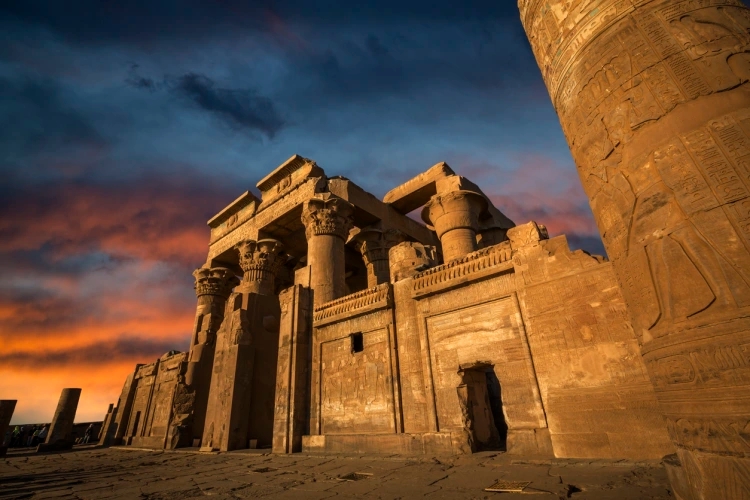
The architectural design of the Temple of Kom Ombo is a marvel of symmetry and precision, reflecting the advanced engineering skills of ancient Egyptian builders. The temple is distinctive for its perfectly mirrored layout, with each side dedicated to one of the two gods: Sobek on the southern side and Horus on the northern side. This symmetry is not only aesthetically pleasing but also serves a symbolic purpose, representing balance and harmony.
Visitors enter the Temple of Kom Ombo through a grand courtyard leading to a hypostyle hall with towering, hieroglyph-covered columns. The detailed reliefs depict gods, pharaohs, and ancient rituals. Beyond the hall lie sanctuaries and chambers once used for offerings and worship, adorned with rich carvings of divine scenes. The temple’s layout invites exploration into Egypt’s sacred past.
One of the most unique features of the Temple of Kom Ombo is its dual dedication, which sets it apart from other temples of the period. This duality is expressed not only in the temple's architectural design but also in its religious symbolism. The temple was a place where both Sobek and Horus were equally revered, reflecting the ancient Egyptians' belief in balance and harmony between opposing forces. Many Egypt tours include this remarkable site, showcasing its significance in the country’s rich history.
The Temple of Kom Ombo features well-preserved carvings that reveal ancient Egyptian life, including depictions of medical tools and procedures, evidence of its role as a healing center. Nearby, the Crocodile Museum displays mummified crocodiles from a local cemetery, reflecting the worship of Sobek and the symbolic power of crocodiles in Egyptian religion and culture.
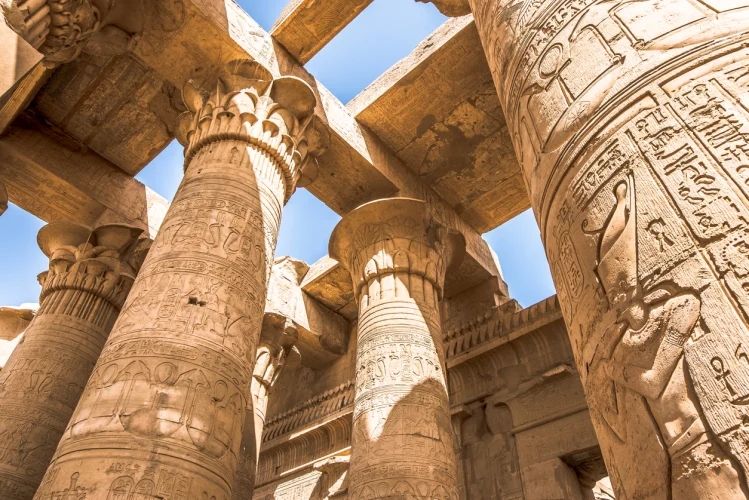
The dual dedication of the Temple of Kom Ombo to Sobek and Horus is a rare and intriguing aspect of its history. Sobek, the crocodile god, was associated with the Nile's power and fertility, making him a vital deity for the agricultural communities along the river. He was also linked to military prowess, and his worship was believed to ensure protection and prosperity.
Horus the Elder, a major sky god, symbolized kingship, protection, and divine order. Often shown as a falcon or falcon-headed man, he was a protector and avenger. The temple’s dedication to Horus underscores its role in royal worship and divine connection.
The temple’s design features separate entrances and sanctuaries for each god, highlighting their equal importance. Walls and columns depict their interactions with pharaohs and rituals, offering insight into ancient Egypt’s complex, intertwined religious beliefs.
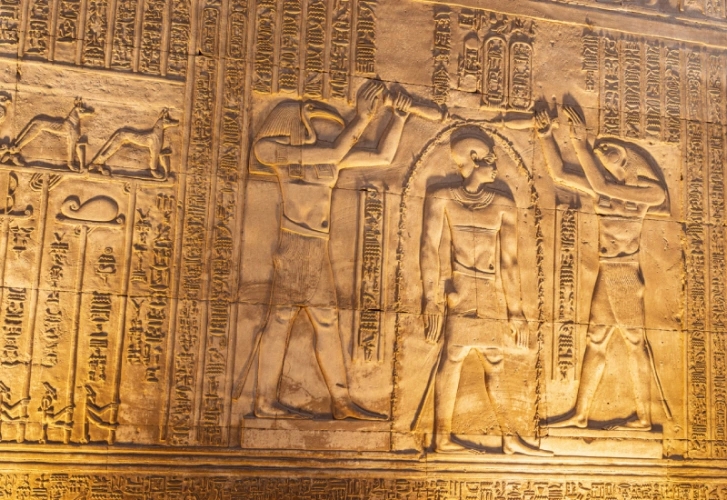
The Temple of Kom Ombo has yielded a wealth of artifacts that shed light on the religious practices and daily life of the ancient Egyptians. Among the most significant discoveries are the numerous reliefs and carvings that adorn the temple walls. These include depictions of pharaohs making offerings to the gods, scenes of daily life, and representations of medical practices that highlight the temple's role as a center of healing.
The crocodile mummies from a nearby cemetery highlight the worship of Sobek and crocodiles' importance in ancient Egypt. Displayed in the Crocodile Museum, they offer visitors a unique insight into the cultural and symbolic significance of crocodiles in Egyptian history.
Besides crocodile mummies, Kom Ombo has pottery, jewelry, and tools that reveal daily life of its worshippers. These artifacts connect us to the past and enrich our understanding of ancient Egypt’s cultural and religious heritage.
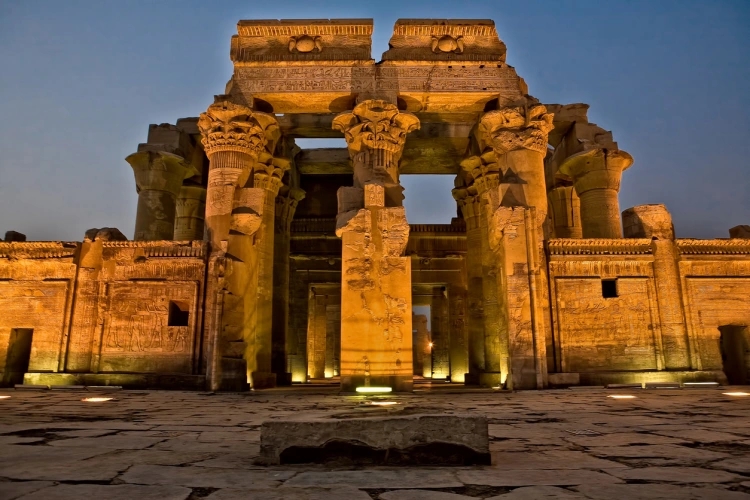
When visiting the Temple of Kom Ombo, travelers can expect to be transported back in time to an era where gods and pharaohs reigned supreme. The temple's location on the banks of the Nile provides a picturesque setting, with the river and surrounding landscapes offering a serene backdrop to the ancient ruins. As one approaches the temple, the grandeur and symmetry of its design become apparent, inviting exploration and discovery.
Visitors to the Temple of Kom Ombo can also explore the nearby Crocodile Museum, home to an impressive collection of crocodile mummies and artifacts linked to the worship of Sobek. The museum offers valuable insights into the cultural and religious importance of crocodiles in ancient Egypt, enhancing the overall experience and understanding of the temple’s significance.

The best time to visit the Temple of Kom Ombo is during the cooler months of the year, from October to April, when the temperatures are more moderate and comfortable for exploring the outdoor site. During this period, the weather is generally pleasant, with clear skies and cooler nights, making it an ideal time for sightseeing and photography.
Visit the Temple of Kom Ombo early morning or late afternoon to avoid crowds and heat, plus enjoy softer light perfect for photos. A Nile cruise stop offers a unique approach by water, echoing ancient pilgrimages. Whether by land or river, the temple promises an unforgettable journey into Egypt’s rich history and culture.
1. Start Early: Plan to arrive at the temple early in the morning to beat the heat and the crowds. This will give you ample time to explore the site at your own pace and enjoy the tranquility of the early hours.
2. Dress Comfortably: Wear lightweight, breathable clothing and comfortable walking shoes. The temple complex requires some walking, and the terrain can be uneven in places. A hat, sunglasses, and sunscreen are also recommended to protect against the strong Egyptian sun.
3. Stay Hydrated: Bring plenty of water to stay hydrated, especially if visiting during the warmer months. There are limited facilities at the site, so it's best to come prepared.
4. Hire a Guide: Consider hiring a knowledgeable local guide to enhance your visit. They can provide valuable insights into the history and significance of the temple, as well as point out details you might otherwise miss.
5. Explore the Crocodile Museum: Don't miss the opportunity to visit the Crocodile Museum, located next to the temple. It houses an impressive collection of crocodile mummies and artifacts that offer a deeper understanding of the worship of Sobek.
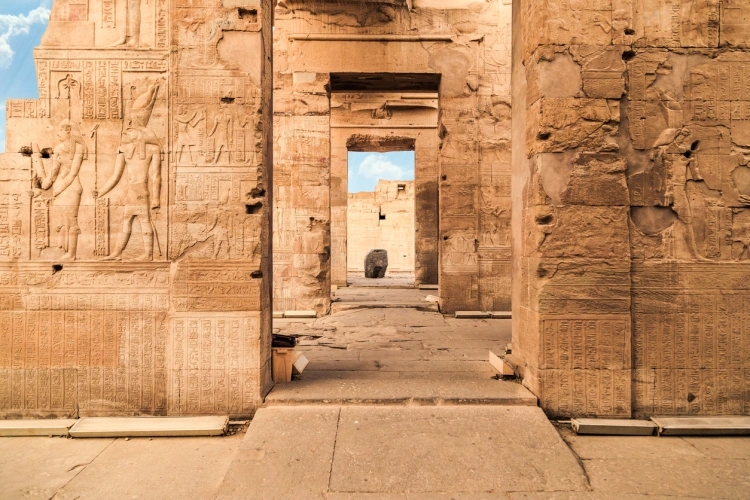
The Temple of Kom Ombo is a testament to ancient Egypt’s spirituality and ingenuity. Its dual dedication to Sobek and Horus highlights balance in Egyptian beliefs. With stunning architecture and rich history, it captivates visitors worldwide. The temple offers a glimpse into a world of gods and pharaohs, inviting exploration and discovery. For those curious about ancient Egypt, Kom Ombo promises an unforgettable journey into this fascinating civilization.
Q1. Where is the Temple of Kom Ombo located?
It is located in Upper Egypt, about 40 kilometers north of Aswan, on the eastern bank of the Nile River.
Q2. What is unique about the Temple of Kom Ombo?
The temple is uniquely dedicated to two gods: Sobek, the crocodile god, and Horus the Elder, the falcon-headed sky god. Its symmetrical design reflects this dual dedication.
Q3. Can I see crocodile mummies at the Temple of Kom Ombo?
Yes, The nearby Crocodile Museum houses a fascinating collection of crocodile mummies found in the local crocodile cemetery.
Q4. How do I get to the Temple of Kom Ombo?
You can reach the temple by road from Aswan or Luxor, or by Nile River cruise, which offers a scenic approach by boat.
Q5. What are the best times to visit the Temple of Kom Ombo?
Early morning or late afternoon visits are recommended to avoid the heat and crowds, and to enjoy the best light for photography.
Q6. Is there an entrance fee to visit the Temple of Kom Ombo?
Yes, there is a small entrance fee, which varies depending on nationality and ticket type.
Q7. What can I expect to see inside the Temple of Kom Ombo?
Visitors will see the dual entrances, hypostyle hall, sanctuaries dedicated to Sobek and Horus, detailed hieroglyphics, and reliefs depicting rituals and ancient medical practices.
Q8. Is the Temple of Kom Ombo suitable for families?
Yes, it’s family-friendly and offers educational insights into Egyptian history, religion, and medicine, which can be fascinating for all ages.
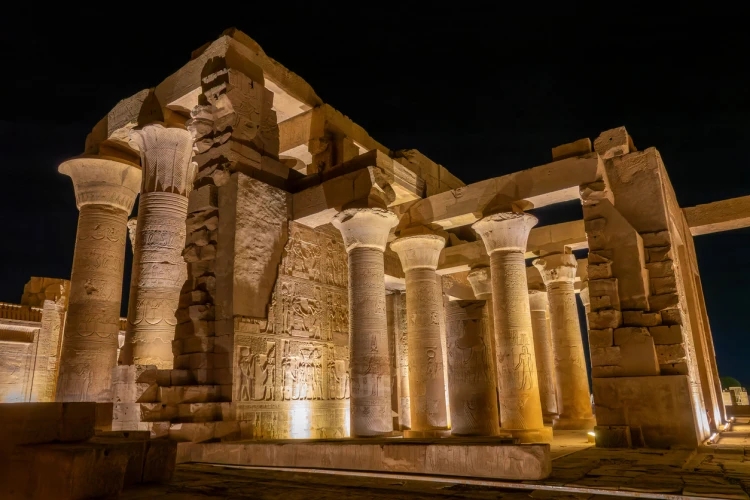

© Copyright 2025 Get Egypt Tour. All rights reserved.